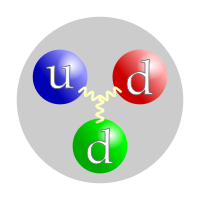
Photo from wikipedia
Abstract Boron–neutron capture therapy (BNCT) is a cancer treatment method that exploits the high neutron reactivity of boron. Monitoring the prompt gamma rays (PGs) produced during neutron irradiation is essential… Click to show full abstract
Abstract Boron–neutron capture therapy (BNCT) is a cancer treatment method that exploits the high neutron reactivity of boron. Monitoring the prompt gamma rays (PGs) produced during neutron irradiation is essential for ensuring the accuracy and safety of BNCT. We investigate the imaging of PGs produced by the boron–neutron capture reaction through Monte Carlo simulations of a gamma camera with a SrI2 scintillator and parallel-hole collimator. GAGG scintillator is also used for a comparison. The simulations allow the shapes of the energy spectra, which exhibit a peak at 478 keV, to be determined along with the PG images from a boron–water phantom. It is found that increasing the size of the water phantom results in a greater number of image counts and lower contrast. Additionally, a higher septal penetration ratio results in poorer image quality, and a SrI2 scintillator results in higher image contrast. Thus, we can simulate the BNCT process and obtain an energy spectrum with a reasonable shape, as well as suitable PG images. Both GAGG and SrI2 crystals are suitable for PG imaging during BNCT. However, for higher imaging quality, SrI2 and a collimator with a lower septal penetration ratio should be utilized.
Journal Title: Nuclear Engineering and Technology
Year Published: 2020
Link to full text (if available)
Share on Social Media: Sign Up to like & get
recommendations!